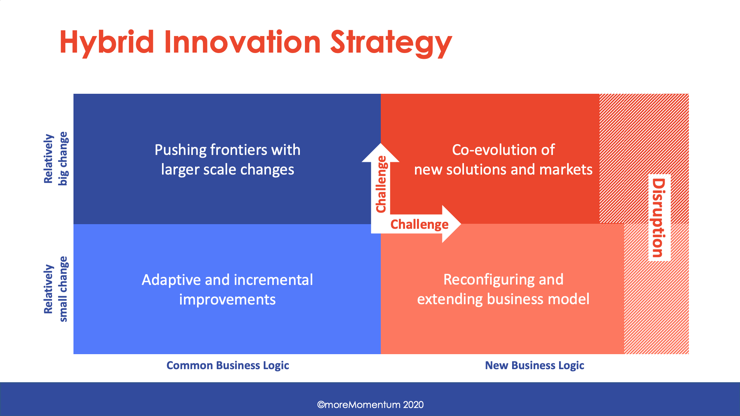Navigating the Digital Shift: Understanding Transformation Patterns in Data Services
Navigating the evolution of data-driven services requires understanding key patterns and embracing innovation. Learn about the journey from concept...

Mastering service innovation in data-driven solutions requires overcoming challenges like strategic alignment, balancing goals, and managing risks. This article explores innovation strategies and frameworks that help navigate the complexity, empowering your organisation to excel in the competitive data-driven service landscape.
Imagine this: Your organisation has begun integrating data and software into its existing equipment and capturing (transactional and customer data) to offer new services, promising improved customer value and internal capabilities.
But as you dive deeper into developing data-driven services, you face shifting customer needs and a complex transformation in value propositions, business models, and internal operations. This scenario reflects the challenge many senior service executives encounter while trying to unlock the full potential of data-driven services.
Data-driven services encompass various business functions, from customer relationship management and predictive maintenance to advanced services and strategic planning. Their impact can lead to more efficient operations and innovative value propositions.
However, realising these opportunities requires careful navigation of complex internal and external factors, such as aligning teams with new goals, overcoming resistance to change, and building the technical skills needed for implementation.
In this article, we will explore strategies for managing and navigating the complexities of innovation in data-driven services. We'll highlight critical frameworks, organisational considerations, and practical insights to help you align your innovation efforts with your business goals and embrace the transformative potential of data-driven services.
In data-driven services, organisations face a dual set of challenges that can complicate the path to innovation.
Externally, rapid technological advancements and innovations by competitors create a fast-paced environment in which staying ahead requires constant adaptation and quick integration of new technologies.
Internally, the challenges can be even more daunting. Cultural resistance to change within the organisation can stifle new initiatives before they gain momentum. Additionally, a lack of expertise in data-driven technologies and innovation methodologies often leads to uncertainty and hesitation among teams and stakeholders.
These internal and external pressures need careful management to ensure they do not derail the strategic objectives of data-driven initiatives.
One of the most overlooked challenges is managing the diversity of data-driven innovations.
Each type of innovation, whether incremental improvements, radical business model changes, or exploring new markets, requires a tailored approach. For instance, developing new value propositions for customers might call for redefining internal capabilities, while achieving short-term performance improvements relies on optimising existing infrastructure. Likewise, incremental changes can be managed within business logic, while radical shifts demand new frameworks and mindsets.
These differences significantly influence how companies allocate resources, identify risks, and engage stakeholders. Incremental innovation often aligns with familiar processes and risk profiles, but more radical innovations involve uncertain outcomes and may require specialised teams to explore emerging markets. Without a clear understanding of these nuances, organisations risk using a one-size-fits-all strategy that leaves some initiatives under-resourced and others stifled by excessive caution.
A significant barrier to adopting and effectively implementing data-driven services is many organisations' philosophical and strategic misalignment.
There is a common industry misunderstanding regarding the true value and appropriate approach to data-driven innovations. Some view these initiatives as IT upgrades or enhancements rather than integral parts of the business strategy that can redefine customer relationships and open new revenue streams.
This misalignment clouds decision-making and limits the scope of data-driven projects, often relegating them to siloed functions without integrating them into the broader business strategy.
Clearing up these misunderstandings and aligning the organisation's philosophy around data-driven innovation is crucial for transforming operations and maintaining a competitive edge.
In practice, the challenges of data-driven innovation can surface as missed opportunities and strategic missteps that affect daily operations. For instance, a service team may collect vast amounts of data from customer equipment yet fail to leverage this data to provide meaningful insights for predictive maintenance due to inadequate analytical tools or lack of training.
As a result, they miss the chance to offer a proactive, value-added service, which can affect customer satisfaction and retention.
Moreover, strategic missteps often occur when organisations adopt new data-driven service models without fully understanding their customers' evolving needs or internal readiness.
A company might invest heavily in a new data analytics platform, only to realise later that their current infrastructure cannot support the data flow, resulting in significant delays and wasted resources. These mistakes erode customer trust and weaken the company’s market position.
Another critical challenge lies in managing stakeholders' expectations and maintaining alignment, particularly given their differing risk appetites and visions for the company.
Stakeholders from various departments—product development, marketing, and IT—may each have a distinct perspective on data-driven services, creating conflicting priorities that can impede progress. For instance, while marketing might focus on short-term gains through immediate service improvements, IT may prioritise long-term technological infrastructure needs.
This disparity often leads to fragmented initiatives that lack a unified strategy, resulting in half-implemented projects that fail to deliver desired results.
Furthermore, balancing risk tolerance is tricky. Some stakeholders may be overly cautious, preferring predictable returns over innovative experiments, while others may advocate for radical, high-risk changes. Striking the right balance requires continuous dialogue, clear communication of the strategic vision, and a shared understanding of the risks and rewards involved in each data-driven initiative.
Strategic alignment is essential for successfully navigating the complexities of data-driven innovation. Organisations must integrate their innovations into the broader business strategy to achieve this. For example, if a manufacturing company wants to implement predictive maintenance services, they should align this initiative with overarching goals like customer satisfaction, cost reduction, and equipment reliability. This alignment ensures that every innovation project contributes to the bigger picture and receives appropriate funding, support, and visibility.
In another scenario, a company aiming to diversify its service offerings might prioritise customer data integration to enhance its understanding of usage patterns. This approach can inform targeted marketing strategies and improve product development efforts. By embedding these initiatives within their long-term strategic objectives, organisations ensure consistency and provide clear guidelines for prioritising resources.
Balancing short-term improvements with long-term transformative goals requires a flexible approach. Companies should adopt a dual strategy:
Organisations can allocate resources appropriately by clearly defining each project's goals and avoiding over-committing to either side. This ensures quick wins while laying the groundwork for long-term transformation.
To make data-driven innovation manageable, it's crucial to differentiate innovations based on their value drivers. Here’s how:
Categorizing innovations this way allows companies to assess each initiative's immediate and future impact and allocate resources according to its strategic value.
Each type of data-driven innovation requires an appropriate organisational strategy:
Innovation inherently carries risk. Effective strategies to manage these include:
Managing risks and ensuring stakeholder alignment requires continuous communication and a balanced approach to project selection. With these strategies, organisations can harness the full potential of data-driven innovation.
Data-driven services present unique challenges and opportunities, requiring a strategic approach to align innovation with business goals. By balancing short- and long-term objectives, differentiating value drivers, and adopting the right organisational strategies, businesses can better manage the risks and complexities involved. Clear communication and a diversified innovation portfolio will foster stakeholder engagement and mitigate risks.
Reflect on your organisation's current strategies and identify areas for improvement. Implement these frameworks to navigate data-driven innovations more effectively, achieve sustainable growth, and deliver enhanced customer value.
Join us at the Service Transformation Summit: "Driving Value with Data-Driven Services"
Expanding upon the themes discussed in this article, the Summit will further explore:
This pivotal event, scheduled for November 13-14, 2024, represents an unparalleled opportunity to deepen your insights into data-driven service transformation. It's the perfect venue to connect with industry pioneers, engage in meaningful discussions, and examine case studies that resonate with your challenges and ambitions.
If you're committed to harnessing the power of data to revolutionise your services and drive organisational growth, we invite you to join us and your peers at the Summit.
Let's embark on this transformative journey together.
Subscribe for the our Impulse Letter
With regular updates about service news, trends and best practices.

Navigating the evolution of data-driven services requires understanding key patterns and embracing innovation. Learn about the journey from concept...

Unlocking value in data-driven services is vital to strategic business growth and operational efficiency. Explore frameworks, strategies, and...

A balanced mix of sustaining, adjacent, and transformational innovations is essential for long-term success in B2B manufacturing, but many companies...